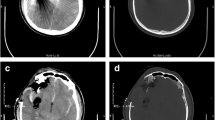Summary
Between 1976 and 1982 46 patients with gunshot injuries (43 m., 3 f.) were seen at the University of Heidelberg Department of Surgery. Frequent causes of injury in 42 adults (40 m., 2 f.) and 4 children (3 m., 1 f.) were suicide attempts (19) and carelessness in the handling of shotguns (11). Criminal offence was related to nine injuries; no retrospective classification of the event causing the injury was possible in further seven cases. Affected in descending order of frequency were brain and lung (10 each), soft tissue of thigh (9), intraabdominal organs (5), heart (4), liver and bone (3 each), blood vessels (2) and facial skull, penis, buttock, neck and mediastinum (1 each). Six patients suffered from combined injuries, in three cases a combined abdomino-thoracic injury was seen. Whilst suicidal injuries of the skull are related to poor prognosis, other peacetime gunshot wounds are less problematic when compared to military gunshot wounds due to the lower speed of the projectiles. Therapeutic procedures follow the general rules of open treatment of injuries including prophylaxis against tetanus and botulism as well as systemic antibiotic therapy. In general abdominal and abdomino-thoracic gunshot wounds as well as vascular injuries require immediate surgical procedure. In isolated thoracic injuries a conservative approach may be justified depending on the situation. The same rule applies to fractures caused by gunshots.
Zusammenfassung
An der Chirurgischen Universitätsklinik Heidelberg wurden von 1976 bis 1982 insgesamt 46 Schußverletzungen (43 m., 3 w.) behandelt. Häufige Verletzungsursachen bei 42 Erwachsenen (40 m., 2 w.) und 4 Kindern (3 m., 1 w.) waren Suicidversuche (19) sowie Unachtsamkeit im Umgang mit Schußwaffen (9). Im Zusammenhang mit Straftaten standen elf Verletzungen, in sieben Fällen war der Hergang des Ereignisses retrospektiv nicht einwandfrei zu klären. Betroffen waren in abnehmender Häufigkeit Gehirn und Lunge (je 10), Weichteile des Oberschenkels (9), innere Hohlorgane (5), Herz (4), Leber und Knochen (je 3), Gefäße (2), sowie Gesichtsschädel, Penis, Gesäß, Nacken und Mediastinum (je 1). Sechs Patienten wiesen Mehrfachverletzungen auf, dreimal lag eine kombinierte abdomino-thorakale Schußverletzung vor. Während suicidale Schußverletzungen des Schädels von schlechter Prognose gekennzeichnet sind, weisen andere Schußverletzungen im Frieden wegen der im Vergleich zu Kriegswaffen geringeren Geschoßgeschwindigkeit weniger Probleme auf. Bezüglich der Versorgung gelten die allgemeinen Regeln der offenen Wundbehandlung mit Gasbrandund Tetanusprophylaxe sowie einer parenteralen Antibiotica-Therapie. Grundsätzlich erfordern abdominelle sowie abdomino-thorakale und Gefäß-Schußverletzungen eine sofortige operative Revision, wogegen bei alleinigen Thoraxverletzungen eine abwartende Haltung gerechtfertigt sein kann. Gleiches gilt für Schußbrüche.
Similar content being viewed by others
Literatur
Amato JJ, Billy LJ, Lawson NS, Rich NM (1974) High velocity missile injury. An experimental study of the retentive forces of tissue. Am J Surg 127:454–458
Borja AR, Ransdell HT (1971) Treatment of penetrating gunshot wounds of the chest. Am J Surg 122:81–84
Drapanas Th, Hewitt RL, Weichert RF, Smith AD (1970) Civilian vascular injuries: A critical appraisal of three decades of management. Ann Surg 172:351–360
Fischer H (1979) SchuBverletzungen im Frieden und ihre Behandlung. Fortschr Med 97:49–52
Fuchs EC, Tegtmeier R (1974) The problem of gunshot injuries of the spinal chord and cauda equina (report on 10 patients). Neurochirurgia 17:153–162
Hampton OP (1961) The indications for debridement of gun shot (bullet) wounds of the extremities in civilian practice. J Trauma 1:368–376
Harvey EN, McMillan JH, Butler EG, Peckelt WE (1962) In: Beyer JC (ed) Wound ballistics. Washington DC, Office of the Surgeon General, Department of the Army, pp 143–236
McAlvanah M, Shaftan G (1978) Selective conservatism in penetrating abdominal wounds: A continuing reappraisal. J Trauma 18:206–212
Morgan MM (1961) Debridement of civilian gunshot wounds of soft tissue. J Trauma 1:354–359
Nance FC, Wennar MH, Johnson LW et al (1974) Surgical judgement in the management of penetrating wounds of the abdomen — Experience with 2212 patients. Ann Surg 179:639–646
Röding H (1961) Zur Frage der primären Versorgung von SchuBverletzungen im Frieden. Monatsschr Unfallheilkd 64:255–264
Talbert J, Gruenberg JC, Brown RS (1980) Peritoneal lavage in penetrating thoracic trauma. J Trauma 20:979–981
Virgilio RW (1970) Intrathoracic wounds in battle casualties. Surg Gynecol Obstet 130:609–615
Waisbrod H (1978) Die Behandlung von SchuBfrakturen. Tiberias: Staatl Poria-Krankenhaus, Orthopäd Abteilung (Eigenverlag)
K-H Wedel (1978) Kriegschirurgisches Symposion 77, Wehrdienst und Gesundheit, Bd 19. Verlag Wehr und Wissen, Koblenz
Author information
Authors and Affiliations
Rights and permissions
About this article
Cite this article
Wagner, M., Comberg, H.U. & Pfaff, G. Schußverletzungen im Frieden und deren Therapie. Langenbecks Arch Chiv 362, 275–288 (1984). https://doi.org/10.1007/BF01254655
Received:
Issue Date:
DOI: https://doi.org/10.1007/BF01254655




